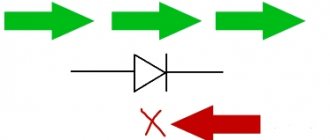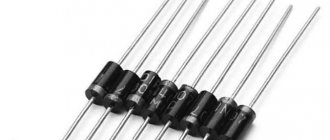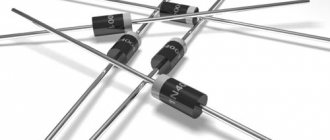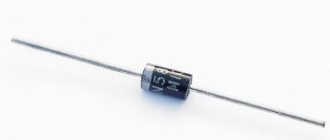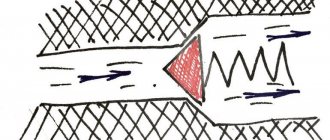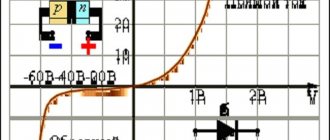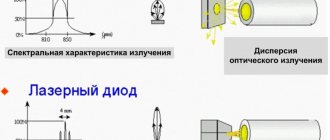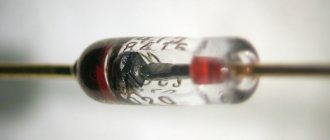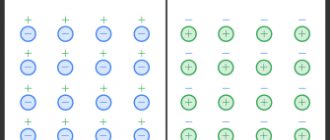On the device in the car, if it was connected incorrectly, the diode broke and there is only 1 of it, can I replace it with the same one, only on the bottom there is a UPM marking. And what possible consequences can await me if I install it. Fuel measuring device.
I apologize if the question is not entirely on topic, but the Technology section is very rotten.
Anyone who is at least a little familiar with the conversion of alternating current to direct current understands that this matter cannot be done without the participation of a diode bridge, which cuts off part of the sinusoid. If we take a cell phone charging unit as an example, then almost all such devices use the same type of elements to assemble it, and the best option for this purpose is considered to be 1n4007 or its analogues.
First, let's try to figure out what it is, what its advantages over others are and consider the characteristics.
This line of diodes contains 1n, from 4001 to 4007, and, for example, a component such as 1n4004, whose characteristics are similar to 1n4007, differs only in current. Both one and the other are suitable for working with a mains voltage of 220 volts.
In general, if the circuit contains a rectifier bridge based on the specified components, the best option would be to install 1n4007, as it has the highest parameters in this line, and at the same time does not have any special differences with weaker diodes.
Characteristics
- The material of manufacture is silicon.
- Transition. Manufactured using diffuse technology.
- Low forward voltage.
- Large pulse current in the forward direction.
- Soldering. Solders with a melting point of up to 275 °C are used, the operation time is no more than 10 seconds.
- Housing – DO-41 (DO-204AL), smd DO-214AC
- The material of manufacture is epoxy resin.
- Fire resistance of the housing - UL 94 V-0.
- Conclusions. Prepared for soldering and meeting the requirements of international standards J-STD-002 and JESD 22-B10.
- Cathode. Indicated by a colored stripe on the body.
Description of 1N400X series diodes
The most popular series of rectifier silicon single-amp diodes among developers, manufacturers and hobbyists is 1N400X, where X=1...7 (indicates the device number in the series).
Diodes are available in DO-41 package, specially designed for two-terminal semiconductor devices intended for relatively high currents and voltages. It is a cylinder made of non-flammable polymer and two wire leads. The cathode is marked with a white (silver) ring stripe. Another name for the package is DO-204-AL. The SOD-66 marking is also used. The dimensions for this case are:
- plastic cylinder diameter – 2.04…2.71 mm;
- cylinder length – 4.07…5.2 mm;
- output diameter - 0.72...0.86 mm;
- Lead length before molding is 25.4 mm.
The leads can be bent at a distance no closer than 1.27 mm from the body.
All devices in the series have the same dimensions, so they can be distinguished within the line only by the inscription on the body. Unfortunately, diodes from unknown manufacturers do not always have this marking. The 1N400X series devices are used very widely. Production in huge series allows us to keep the wholesale price of diodes to no more than a few cents per piece, and this is also the reason for the wild popularity of the product.
General characteristics
| Designation | Parameter | Magnitude |
| IF(AV) | Direct current | 1.0A |
| IFSM | Sinusoidal forward current, T=8.3 ms | 30 A |
| IFSM | Rectangular forward current, T=1 ms | 45 A |
| VF | Forward voltage | 1.1 V |
| IR | Reverse current | 5.0 μA |
| TJ max | Maximum junction temperature | 150 °C |
| Designation | Parameter | 1N4001 | 1N4002 | 1N4003 | 1N4004 | 1N4005 | 1N4006 | 1N4007 | Unit change |
| VRRM | Peak Repetitive Pulse Reverse Voltage | 50 | 100 | 200 | 400 | 600 | 800 | 1000 | V |
| V.R.W.M. | Peak operating reverse voltage | ||||||||
| VDC | Constant blocking voltage | ||||||||
| VRMS | RMS voltage | 35 | 70 | 140 | 280 | 420 | 560 | 700 | V |
| IF(AV) | Average rectified current, TA = 75 °C | 1 | A | ||||||
| IFSM | Direct peak non-periodic overload current | 30 | A | ||||||
| VFM | Forward voltage at IF = 1.0A | 1 | V | ||||||
| IRM | Peak reverse current at TA =25°C | 5 | μA | ||||||
| IRM | Peak reverse current at blocking voltage and TA=100°C | 50 | μA | ||||||
| Cj | Transfer capacitance | 15 | 8 | pF | |||||
| RθJA | Thermal resistance air-to-air junction | 100 | K/W | ||||||
| T.A. | Temperature at maximum blocking voltage | 150 | °C | ||||||
| T.J., T.S.T.G. | Operating and storage temperature range | -65…+150 | °C | ||||||
Specifications and Applications
- Weight - 0.33 g;
- Constant reverse voltage (max): 1000 Volts;
- Constant Current (Max): 1 Ampere (at 75 degrees Celsius);
- Forward Voltage (Max): 1.1 Volts;
- Operating temperature: -65…+175 degrees Celsius.
The main area of application of such diodes is current rectifiers, as mentioned above. They also performed well in power electronics, where they are used mainly as an analog amplifier. When using them in any devices, naturally, the technical characteristics also improve. The thing is that such elements are very powerful and operate in installations with voltages of up to 1000 volts.
In addition, such elements are quite successfully used in power supply circuits that have output voltage regulation, which is, again, due to the high endurance ratings of these diodes.
If we talk about the possibility of replacing such elements with analogues, then it is quite appropriate to replace 1n4007 with the Russian development KD258D. This domestic diode is in no way inferior to 1n4007, and therefore you can safely install it. It is also possible to use foreign analogues, such as IN3549 or IN2070.
Analogs
Domestic analogues presented in the table are considered for 1N4007:
| Replacement | VR | VF | IF |
| 1N4007 | 1000 | 1 | 1 |
| KD528D | 1000 | 1,5 | |
| KD243Zh | 1000 | 1,1 | 1,5 |
Note: the data in the table for the 1N4007 diode and those suitable for replacement are taken from the manufacturer's datasheet.
Imported manufacturers offer larger rectifier diodes to replace the 1N400X. The most suitable technical parameters are:
- HEPR0056RT (Motorola),
- BYW27-1000 / BY156 (SGS Thomson Microelectronics),
- BYW43 (Siemens AG),
- 10D4 / 1N2070 / 1N3549 (several US manufacturers).
Diode 1N4007 characteristics:
- maximum long-term forward current at 75°C - 1.0 A;
- maximum pulse current with a pulse duration of 3.8 ms - 30 A;
- voltage drop across the diode at a current of 1.0A - 1.1 V;
- operating temperature range - -65…+175°С;
- maximum operating frequency - 1 MHz;
In addition to the reverse voltage, an essential characteristic is the forward current; for the 1N4007 it reaches 1 A. Theoretically, these diodes could be used in a 220 W switching power supply if good heat dissipation from the diodes is ensured (for example, by filling them with compound), but it is not so extreme approach these diodes and in the input rectifier of a 220 V power supply, you should not exceed a power of 50 - 100 W, depending on the efficiency of the cooling system.
Diode parameters
The 1N4007 diode is a planar silicon diode with parameters standard for medium-power voltage rectifiers operating at frequencies up to 1000 Hz. In some descriptions there may be incorrect designations like in4007. Available in a DO-41 plastic case, with tinned wire axial leads, for through installation into printed circuit board holes (THT). The DO-35 and A-405 versions differ slightly in size. Surface mount (SMD) products are manufactured in DO-214 (SMA) package. Appearance In most cases, the DO-41 case is painted with abrasion-resistant paint with the full name of the diode - 1N400X.
The marking of SMD components, on which it is impossible to place the full name, has several options determined by the device manufacturer: S7, M7, A7 and others. The number here corresponds to the last one in the full designation. The negative terminal (cathode) is always indicated by a white or gray stripe. There are no special installation requirements; soldering of leads for DO-41 is allowed at temperatures up to 260 °C, for no more than 10 seconds, at a distance of 9.5 mm from the housing. Operating and limiting parameters For 1N4007, characteristics are measured at an ambient temperature of 25 ° C, unless otherwise specified.
The 1N4007 diode is one of the representatives of a whole series of diodes 1N4001, 1N4002, 1N4003, 1N4004, 1N4005, 1N4006, 1N4007. These types of diodes differ in the value of the maximum permissible reverse voltage (the values for each type are given in the table). 1N4007 is designed for the highest voltage. Comparative characteristics are presented in the table below:
Table of comparative characteristics of the 1N4007 diode and others
Material on the topic: What is a capacitor
The device is switched on using a half-wave rectifier circuit, frequency – 60 Hz, a resistive or inductive load is used. 1n5819 diode: characteristics Characteristics:
- Peak and constant limit reverse voltage – 1000 V;
- Maximum average (RMS) alternating voltage – 700 V;
- Maximum average rectified current – 1.0 A at 75 °C;
- Peak forward current during one half-cycle – 30 A;
- Voltage drop at current 1 A – 1.0 V;
- Thermal resistance crystal - case - 25 oC/W;
- Typical junction capacitance is 15 pF for a frequency of 1 MHz;
- Operating temperature – from -55 to +155 оС.
It will be interesting➡ How to decipher the color coding of transistors?
Other diodes in this line differ only in the values of permissible reverse voltages; they are indicated by the last digit in the marking - from 50 to 800 volts. Important to consider! The limiting value of the forward current depends on the temperature of the case (1 watt of power causes an increase of 25 ° C); in critical designs it is recommended to provide sufficient heat dissipation; in some cases, board pads can be used. Dependence of current on temperature Application features The characteristics of the 1N4007 diode determine the areas of its use - these are AC voltage rectifiers with a frequency of 50/60 Hz. For a 220 volt network rectifier, 1N4007, 05, 06 are used.
In low-power, low-voltage devices (transformer power supplies), the 1N4001 diode can be used with standard output voltages of 12, 24, 36 volts. They do not work at frequencies above 1 kHz: for example, installing a switching power supply in the output stage will lead to unpredictable consequences, including failure of the entire structure. In4007 rectifier diodes do not have unique properties and can be replaced by any with similar parameters, produced in huge quantities by all manufacturers. Domestic rectifier diodes KD243 are complete analogs, like KD208A, KD212. The only difficulty when replacing with Russian products may arise when determining the type - traditionally, domestic manufacturers mark their products with multi-colored stripes or dots, and the information contained in them can only be deciphered using reference books.
Diode 1n4007.
The 1N4007 diode is probably the most popular of all diodes, as it is installed in the vast majority of phone chargers, smartphones and tablets. Even if you are holding a charger for a dollar and there is no stabilization or interference filters inside, it cannot do without a diode. And in one adapter there are four such diodes and a diode bridge is assembled on them; it is used to obtain direct voltage from alternating voltage. The diode allows current to pass through itself in only one direction, cutting off one of the voltage polarities.
Packaging of diodes.
By the way, especially cheap chargers use half-wave rectification and save three out of 4 diodes. But if the power of the power supply is more than one Watt, then it is still better to use a diode bridge, since unipolar rectification produces much larger ripples, and this mode is much more difficult for filter capacitors.
The colored ring on the 1N4007 body indicates the cathode terminal. Since the 1N4007 is produced with leads of sufficient length, the diode can be installed both vertically and horizontally. The 1N4007 diode is one of the representatives of a whole series of diodes 1N4001, 1N4002, 1N4003, 1N4004, 1N4005, 1N4006, 1N4007. These types of diodes differ in the value of the maximum permissible reverse voltage (the values for each type are given in the table). 1N4007 is designed for the highest voltage.
Since the cost of diodes from the entire 1N4001-1N4007 series is very low, and there is practically no difference in cost between types, there is no particular point in using different types in development and increasing the range. You can install 1N4007 everywhere, even if during repairs you need to replace a diode from this series with a lower voltage.
It will be interesting➡ What is the Gunn effect and what do diodes have to do with it
Analogs 1N4007
Of course, such a popular diode could not be ignored by global manufacturers of semiconductor devices and released their complete analogues:
- Motorola - HEPR0056RT;
- Philips - BYW43;
- Diotec Semiconductor - 10D4, 1N2070, 1N3549;
- Thomson - BY156, BYW27-1000;
- domestic analogue - KD258D.
Rectifier diodes 1N4001 – 1N4007 Diodes 1N4001, 1N4002, 1N4003, 1N4004, 1N4005, 1N4006, 1N4007 have high throughput and low forward voltage drop. In terms of applicability, diodes 1N4001 - 1N4007 are general purpose diodes that rectify currents in circuits up to 1A with a voltage of 50V - 1000V. Diodes of these series have the ability to accumulate charge up to 20pF and can be temporarily used as varicaps. Diode housing type – DO-41. The body material is non-flammable polymer. Operating frequency – up to 60Hz.
Material on the topic: What is a time relay
The cathode terminal of the diode is indicated by a stripe. The diode outputs are axial, the type of installation is through holes, for soldering. The most common use of diodes is in power supplies for various household appliances. The characteristics of the diodes are shown in the table below. The operation guarantee of the diodes 1N4001 – 1N4007 supplied by our company is 2 years. This is supported by the necessary quality documents. The final price for diodes 1N4001, 1N4002, 1N4003, 1N4004, 1N4005, 1N4006, 1N4007 depends on the quantity, delivery time, manufacturer, country of origin and form of payment.
Diodes 1n4007.
